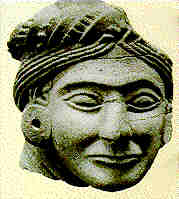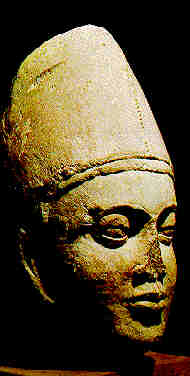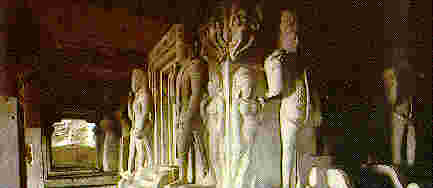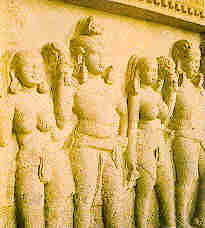
|
_____________________
________________________________-_________________________________________________
The nearest authoritative source which can give us an idea of the Mauryan State apparatus is the Arthashastra - a Sanskrit classic on the principles of politico-economic organisation authored by Chanakya who was the principal adviser to the first Mauryan Emperor, Chandragupta. Guided by the Arthashastra, the Mauryan state became the central land clearing agency with the objective of extending settled agriculture and breaking up the disintegrating remenants of the frontier hill tribes whose members could serve as a useful source of providing labourer-cultivators on these newly cleared forest lands.
Mauryan agriculture had two type of landholdings, one were the Rashtra type of holdings which were the direct descendants of the holdings of the former tribal oligarchies who had been subjugated in pre-Mauryan times. The Rashtra landholdings were to a large extent independent of the state machinery in their internal functioning and administration.
Their only obligation was the regular payment of the Rashtra taxes to the state.
 |
| An elaborately carved torana (panel) from the Sanchi Stupa. This represents a typical Mauryan Village scene. |
The second major type of landholdings were of the type. These Sita landholdings were formed by clearing forest lands with the help of the tribesmen whose tribal way of 1ife had been systematically and annihilated by the Mauryan statecraft. It would be interesting to recollect here the episode about the birth and passing away of Rama' s wife Sita whose name these landholdings bear or perhaps vice versa
The Story of Sita
Janaka the king of Mithila was childless since many years. He prayed to Lord Vishnu and asked for a child. Vishnu blessed him and said that his wish would soon be fulfilled by the mother earth.
But days passed and there was no sign of a new arrival ln the royal family. Janaka's longing for a child increased but he had faith in Vishnu's word. Then one day came the festival of sowing when the king of the land initiated the year's sowing by himself ploughing a field.
When Janaka started the ceremonial ploughing, much to his chagrin the plough got stuck in the soil and refused to budge. After much pulling and pushing, the earth around the plough was dug up to set it free. To the surprise of Janaka and others gathered there, they found that a bejewelled casket was the reason why the plough had got stuck. Their surprise turned into a pleasant shock when they saw that the casket contained a baby girl .
King Janaka guessed that Lord Vishnu's boon had been fulfilled. He gratefully took the baby girl home and named her Sita to commemorate the fact that she was the daughter of the eafth. (Incidentally in Sanskrit the word 'Sita' is also used to mean 'land').
The girl Sita, grew up aa janak's daughter and was eventually married to Rama with whom she spent 14 years in exile during which she was kidnapped by the demon-king Ravana and was rescued by Rama after a fierce battle was fought at Lanka. After this Sita gave birth to two to two sons Luv and Kush. But unfortunately she had to bring her children up at an hermitage as she was forsaken by Rama due to her chastity begin under a cloud for some residents of Ayodhya.. But the family reunion took place eventually when Luv and Kush unknowingly captured Lord Rama's, Ashvamedha horse and gave battle to his army.
But now after the family reunion the question remained of Sita's return to Ayodhya. When Rama asked her to return, she refuse; and prayed to her mother earth to take her back. In response to her prayer the mother earth, we are told, opened up and accepted her. As Sita disappeared into the earth, Rama rushed; to stop her but he could only clutch her hair which remained above the ground as the breach in the earth closed to engulf Sita. Thus, Sita who was born out of earth also returned to the earth for her eternal sleep.
 | The famous Didarganj Yakshi (from the Patna Museum). Yakshis were nymphs in Indian Mythology. This statue also represents a sculpture typical of the Mauryan times. |
The corollary in the name Sita for Rama's queen and also for a type of landholding illustrates the fact that the Sita type of holding must have been a very common type of holding in ancient India such that the word Sita was given to a mythological character who was supposed to have been a daughter of the earth. But this story also illustrates that the Sita type of holdings could have come into being as a new type of landholding which was evolved out of an earlier one (perhaps the Rashtra holding or some other holding) . This was the possible reason why the daughter of the earth, who sprang from the earth was called Sita .
Mauryan Imperialism to Enforce Revenue Collection
However, it was during Maurya rule that the word Sita seems to have come into wide usage and the Sita holdings were a result of clearing up of forest lands mainly with the labour of displaced tribesmen. This clearing up of forests opened contacts with still farther tribes within whom the process of disintegration was then planted by the Mauryan State. Thus was extended the margin of the monarchical revenue system and of settled agriculture as well . The state maintained a close control over the -state owned Sita lands. These lands were not made the property of the cultivator. They were leased to him for his lifetime and he could hold the lease on condition that he cultivated the land and paid taxes. The penalty for non-cultivation was confiscation of the leased land. The reason why the Mauryan State insisted on intensive cultivation with maximum results suggests that taxes in Mauryan times bore a close proportionate relationship with the size of the crop. Hence it was in the interest of augmenting the state's revenue collection, to insist on maximum results.
Mauryan Prohibition on Sale of Land
In Mauryan times, the Sita lands could not be sold or transferred without special permissions Their cultivation too was strictly on a family basis. No form of communal or any other type of work that could arouse common tribal solidarity, was allowed. Even religious associations were restricted. Thus by prohibiting the establishment of any public platform the Mauryan state totally eliminated all possibilities of any popular resistance from the peasant masses. The right to movement was also restricted for the fear of cultivators shifting from the Sita lands to those outside the pale of fiscal jurisdiction.
 | A representation of a merchant from Maurya Times (reproduced from the original at the National Museum Delhi). |
Regimentation of Rural Life
No peasant could even become a monk without making prior provision for his dependants. The Mauryan state took no burden of unproductive citizens upon itself. This explains the barring of entry of Buddhist and Jaina Bhikshus, before Ashoka in these Sita lands. This was aimed at preventing the conversion of peasants into unproductive monks. Agricultural production was not even to be disturbed by non-agricultural pursuits. According to the Arthashastra, there shall be no buildings, in villages, which could be used for sports and recreational activities. Nor shall actors, dancers, singers, drummers, baffons (Vagjivana) and bards (Kushilava) make any disturbance in the work of the villagers.
These extreme provisions were enforced by establishing guarded frontiers for each of the isolated and disjointed agricultural villages called Janapadas. These internal frontiers served the purpose of toll and tax collection and exercising control over the movements of peasants. The state also had a full-fledged network of spies to observe and maintain up-to-date records of every minister and state official to check on their loyalty and honesty. Spies disguised as philosopher-hermits were placed around the residence of every important person. Any sudden acquisition of wealth or suspicious behaviour on part of any important official was closely watched and reported.
such was the steel-framed web of the Mauryan state which enabled preservation of the highly centralized character of the empire.
But the real factor that enabled such centralised functioning was the limited, but widely scattered Janapadas on which taxes had to be levied. But the state got its revenue directly from the peasants with no intermediary in between was in the later feudal ages. The smallness of the fiscal jurisdiction made possible the consistently followed, policy of not giving land grants that could permanently deprive the state from any revenue hence the absence of a hereditary revenue collecting hierarchy of Jagirdars and Subahdars that became a character of later ages.
 | A bust of a Kushana King from the 1st century C.E. (Reproduced from the original at the National Museum, Delhi) |
Mauryan Socialism - State Ownership of the Means of Production
The Mauryan State also undertook commodity production on a large scale. Apart from farmlands it also owned warehouses, shipyards and mines. In short, the Mauryan economy functioned not only without intermediary revenue collectors but also largely without individual owners of means of production in the heavy and basic industries of those days. The state was by far the biggest owner of the means of production and organiser of the normal economic functioning. The reason for this control of agriculture, industry, trade and the levy of all varieties of taxes on the population was perhaps that the state was in dire need of a great amount of surplus for military considerations. Before the Mauryas, no other state in ancient India maintained such a huge standing army as did the Mauryas. But by their policy, the Mauryas introduced important changes in the face of~the rural economy.
New settlements were established and decaying one's were rehabilitated by drafting surplus settlers from the overpopulated area of the Ganges valley. Generally the lower castes were encouraged to move out of the Ganges valley and settle in the new agricultural settlements. Land was leased out to them. In order to make the virgin land cultivable, the state allowed remission of taxes for a few initial years and other concessions by way of supplies of cattle, seeds and agricultural instruments which they were required to repay later. But no land could be sold off by these cultivators, they were supposed to cultivate it and churn out revenue for the state.
 | One of the panels at Ajanta Caves in Maharashtra in Western India. |
The Mauryan Revenue Collectors were Employees of the State
This feature of centralism that characterized the Mauryan state was made possible due to the limited expanse in which the fiscal machinery had to function. Though the agricultural settlement were scattered throughout the empire, the sum-total size of the scattered Janapadas made possible the centralised system of the Mauryas. This centralised system which was built upon the principle of the Arthashastra, did not create a corollary of feudal lords who could occupy the hereditary position of revenue collectors and earn their own income from retaining a part of the revenue collected. In the absence of such a class what came into being was a class of revenue collectors who were the paid officials of the Mauryan State and who resembled the IAS (Indian Administrative Service) revenue collectors of our times rather than the Jagirdars of the middle ages.
But this high bureaucracy and the upper citizenry had its opposite in the form of a proletariat who worked on the Sita state owned farms without a claim to the land they tilled. These tillers of the Sita lands were termed the ardha-sitikas or half share-croppers as they were entitled to only a portion of the crop they reaped, with the rest going to the state as revenue. These relations were basically feudal in nature. This was the reason why these relations were preserved by the various dynasties that followed the Mauryas.
 | Similar to the Ajanta temple are the Kanheri Caves near Mumbai. Seen here is one of the panels from Kanheri. |
During the Post-Maurya and the Gupta periods, the state revenue collectors were absent and their place was taken by the donees of Brahmadeya, Devadana and Agrahara lands, but the position of the share-croppers remained almost unchanged as they had to pass on a share of the crop to the donees in the place of the revenue collectors of the Mauryan State. The donees were feudal intermediaries who passed on a part of the revenue they collected to the king. Later in place of these donees came the Jagirdars, Subahdars and Inamdars during Muslim rule, but the sharecropping system was almost unchanged. It was then known as the Biradari or the Bhaiya-chara system in the middle ages but it was fundamentally similar to the ardha-sitika system of the Mauryan days.
The Zamindari system of revenue collection introduced by the British was an adaptation of the Jagirdari and Inamdari systems of the Muslim rulers. Only that the Zamindars did not have wide administrative powers which the Jagirdars and Inamdars had. But the various forms of land tenure that were reared under the Zamindari system were also basically similar to the ardha-sitika share-cropping system of ancient India. Only after independence and the abolition of Zamindari was an attempt made to make the tiller, the owner of the land and for the state to collect revenue directly from him without any intermediary. But to return to the Mauryas, we have to consider another institution that made its appearance in ancient times i.e. the craftsman guilds.
The Shreni Craftsmen Guilds of the Mauryan Economy
These guilds were called Shreni. Craftsman guilds which were a feature of Europe in the middle ages, made their appearance in India in ancient times but were conspicuous by their absence during the middle ages. This institution of the Shreni was between the tribe and caste in its organisation. Though the historical reasons why these guilds appeared at that particular stage of development are not yet established, it can be inferred with fair accuracy that at the stage when productive forces had advanced upto a limit where specialised occupations could emerge alongwith a division of labour making it possible for individual tribes to specialise in particular occupations, the Shreni guilds made their appearance. These guilds were an adaptation of the tribal set-up when the tribes started specialising in a particular occupation.
 | Such lustrous glass beads have been recorded by Roman chroniclers to have been made in ancient India. |
But in spite of taking on some artisan occupation, these Shreni guilds retained the umbilical cord that tethered them to the tribal organisation. This was perhaps due to a late contact with the hierarchical societies. But in the course of time these Shreni guilds were pulled into the caste hierarchy and the fact that they did obtain a place in this hierarchy, while retaining features of their original tribal organisation (like the right to bear arms), is indicated by the word Shreni itself which means level or grade., The Shreni guilds played an important role in the productive apparatus of the period which saw the flowering of the monarchical states of Koshala and Magadha when the institution of occupational castes had not yet ossified into their classic form.
But the Shreni guilds did not survive during the post-Mauryan times, when the economy was based on self-sufficient villages. Even the centralised land revenue collection system with state-employed salaried revenue collectors, gave way to one based on donees who received no salary from the state but who retained for their own use, a part of the revenue they collected. Thus a change in the nature of revenue collection was necessitated by economic factors like the spreading of farmlands making it difficult to collect revenue through a centralised apparatus, the absence of a well knit empire after the fall of the Mauryan empire and hence the absence of good communication links. All this led to the evolution of locally based, hereditary revenue collectors who were petty administrators, of the chieftains and kings themselves depending on the powers they wielded-whether they were independent or were the vassals of some other king.
Constitutional Checks on the Rights of a King
Another significant development during Mauryan times which indirectly influenced the rise of Feudalism was the victory of Emperor Ashoka over Kumar - the King of Kalinga (Orissa). The battle was a very fierce and bloody one and the heaps of dead bodies turned Emperor Ashoka very remorseful. It was at this juncture that he embraced Buddhism in an attempt to conquer himself before setting out to conquer others.
 | A statue of the Buddha at the Sanchi Stupa in Madhya Pradesh. |
He sent out Buddhist Missionaries to Sri Lanka, China, Korea, Central Asia and spread the Buddhist message of universal love and brotherhood far and wide.
In addition to this, in a marked retraction from the Chanakyan policies of statecraft (as laid down in the Arthashatra), Emperor Ashoka formulated the code of conduct to be followed by an Emperor, the Emperor's duties and obligations towards his subjects. This act of his provided for constitutional checks to regal authority for the first time in recorded history. By this act of his, he also pre-dated the Magna Carta by 1500 years. This codification of a king's duty and obligations are also reflected in later Dharmashastra (Political Administration) literature of the Gupta and post-Gupta times in India.
By this act, Ashoka also undermined the steel-framed web that Chanakyan statecraft had created. The undermining of this structure and also of the related state-apparatus for commodity production, tax collection, espionage, etc., gradually let loose decentralizing tendencies which weakened the Maurya Empire and led to its downfall.
Not only did it result in this, but more importantly, after this downfall, it created a vacuum between the state (king) and the lay people, both for the purpose of revenue collection as also for dispensing justice and maintaining law and order.
This also made necessary the creation of intermediaries to fill this vacuum. This is an important point, which influences the course of later history of revenue collection and political administration in India.
The spread of farmland far and wide to proportions unimaginable in pre-Maurayn times also made the emergence of such a class of intermediary revenue collectors - the Feudal Lords viz. Samants, later called Jagirdars, Subahdars, Mansabdars, indispensable.
 | The Chaitya - Buddhist Prayer Hall at the Ajanta temple complex. |
_________________________________________
Now we move on to examine the change which followed the decline of India's first Pan-Indian empire of the Mauryas and the consequent Fall Towards Feudalism that characterized the middle ages. Between the king and the common population there was now a class of middlemen who were the intermediate revenue collectors. They were variously known as Samants and Saranjamdars (called Thakurs, Chaudharys, Patils, Patels, Deshmukhs, etc) and in later times Subhadars, Jagirdars and Mansabdars.
_____________________________________________________________
_____________________________________________________________________________________
|
|
_ _ _ |
View My Guestbook
|
_______________________________________
_________________________________
